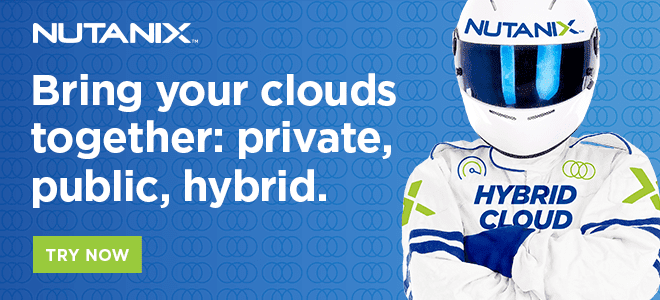Pathways to the cloud seem to get more convoluted every day. Private, on-premises clouds must coexist with SaaS applications and public cloud services. Hybrid multi-cloud architectures are dispersing cloud technologies and moving them beyond massive data centers.
Every enterprise IT department needs a leader who can navigate these twists and turns. At Nutanix, a leading enterprise cloud technology provider, that job falls to Wendy M. Pfeiffer. Since she became Nutanix’s CIO in 2017, she’s been transforming their IT operations to fuse multi-cloud computing with emerging digital technologies like machine learning and artificial intelligence. As she likes to say, she helps Nutanix drink its own Champagne by running the company on the technology it makes and sells around the world. That journey is laid out in an ebook called Charting the Course to Cloud.
In an Ebook titled Charting the Course to Cloud and 10-part podcast series, Pfeiffer shares insights and lessons learned from guiding Nutanix’s journey to hybrid multicloud IT.
Pfeiffer has been in the business of transformation for decades. A Silicon Valley native, she caught the tech bug as a teenager in the 1980s, when she landed a NASA internship that introduced her to the wonders of complex computing systems.
“I loved the idea of these large networks, large computers and the vast interconnectedness of things,” she recalled in a 2019 interview at a Nutanix-sponsored conference.
In the years to come, she would take on leading technology roles at Cisco Systems, Exodus Communications, Robert Half, Yahoo! and GoPro. That experience prepared her for a distinct challenge at Nutanix: helping the company use its own technologies to embrace the full potential of hybrid cloud computing. Founded in 2009, Nutanix pioneered the concept of hyperconverged infrastructure (HCI), which virtualizes the entire data center environment and manages it all from a single software dashboard running on commodity servers.
“And it does so in a way that doesn't require us to retrain our people or find a small team of rocket scientists who are worth more than the GDP of small countries,” Pfeiffer added.
Thus, HCI software reduces total cost of ownership and dramatically simplifies data center operations, making it a crucial tool for companies hoping to streamline and simplify their journey to the cloud. But how would that work at Nutanix, which built a billion-dollar global business around HCI and enterprise cloud software?
Pfeiffer had to figure that out.
Turning to In-House Technologies
At first glance, Pfeiffer faced a familiar enterprise challenge: embracing next-generation technologies while avoiding a rip-and-replace of their current IT infrastructures. Fortunately, she had a career advantage: Working for tech titans like Cisco and Yahoo! showed her the value of adopting the tools they sell to their customers.
“I learned that I was passionate about helping companies take advantage of their own disruption,” Pfeiffer said in a 2019 interview with The Forecast.
It might seem obvious for an HCI innovator to use its own technologies in its journey to the new multi-cloud world, but IT departments don’t always work that way. In the early years, Nutanix’s IT teams relied on vendors, but Pfeiffer helped steer Nutanix to a new path — leaning more heavily on its own hypervisor products and a sophisticated cloud operating system to simplify and automate hybrid multi-cloud ecosystems.
The transition has been fruitful.
“We have some of the best IT operational metrics in the industry,” she added. “We have lean staffing, maintained a six-year average Net Promoter Score of 90 and near 100% availability of our systems in recent years, all while the company enjoyed significant growth.”
The Value of Simplifying, Standardizing and Automating
Unifying its data centers under the banner of HCI helped Nutanix simplify, standardize and automate its hybrid cloud environments.
“We don’t need so many people configuring physical networks in our data centers,” Pfeiffer said in Charting the Course to Cloud, an ebook Nutanix published recommending best practices for the cloud journey.
“In previous IT departments, I had a team of storage engineers, a team of network engineers and a team of backup engineers just to keep the infrastructure up and running,” she recalled.
At Nutanix, she tapped the automation and simplicity baked into their HCI software’s operating system, which relies on machine learning and artificial intelligence to boost performance.
“It is intelligently aware of how the operating system uses resources and can proactively help with capacity planning, including moving workloads as needed,” she stated in the ebook.
“Our hybrid cloud becomes more robust every year,” she added. “Each layer is purpose-built to enable unlimited portability, scalability and performance, without adding complexity to IT management.”
Learning from the Smartphone
The software that enables companies’ multi-cloud journeys should rival the intuitive usability of smartphones, Pfeifer said in the Nutanix ebook: “Ultimately, corporate IT services should be as easy as your smartphone: you simply choose the apps that you want to use, and the technology adapts to your preferences.”
Tech companies may have to build the apps themselves, she suggested. They might turn to machine learning tools to train computers to do things enterprise IT companies can’t seem to deliver.
Whatever IT leaders decide, Pfeiffer advises putting simplicity and ease of use at the center of their journey to the hybrid, multi-cloud future
“And then it's IT leadership's job to create that really rich ecosystem where those applications and tools have the nutrients they need and the capabilities they need to work together.”
Journey to Cloud Podcast Series
Pfeiffer shared the 10 main lessons she learned leading her IT team to transform Nutanix into a hybrid multicloud IT-powered company.
[Related podcast – Step 1:] https://www.nutanix.com/theforecastbynutanix/podcasts/journey-to-cloud-define-new-infrastructure-standards (NOT SHOWING IN PODCAST SECTION)
[Related podcast – Step 2:] https://www.nutanix.com/theforecastbynutanix/podcasts/journey-to-cloud-create-a-flexible-foundation
[Related podcast – Step 3:] https://www.nutanix.com/theforecastbynutanix/podcasts/establish-infrastructure-purpose-built-cloud
[Related podcast – Step 4:] https://www.nutanix.com/theforecastbynutanix/podcasts/the-journey-to-cloud-step-4-focus-on-the-user-experience
[Related podcast – Step 5:] https://www.nutanix.com/theforecastbynutanix/podcasts/the-journey-to-cloud-step-5-institute-autonomous-it
[Related podcast – Step 6:] https://www.nutanix.com/theforecastbynutanix/podcasts/journey-to-cloud-step-6-augment-it-skillsets-with-ai-and-ml
[Related podcast – Step 7:] https://www.nutanix.com/theforecastbynutanix/podcasts/journey-to-cloud-step-7-measure-success-by-delighting-it-users
[Related podcast – Step 8:] https://www.nutanix.com/theforecastbynutanix/podcasts/journey-to-cloud-step-8-monitor-customer-satisfaction-results
[Related podcast – Step 9:] https://www.nutanix.com/theforecastbynutanix/podcasts/validate-the-business-case-with-roi
[Related podcast – Step 10:] https://www.nutanix.com/theforecastbynutanix/podcasts/journey-to-cloud-step-10-adopt-an-attitude-of-continuous-improvement
Tom Mangan is a contributing writer. He is a veteran B2B technology writer and editor, specializing in cloud computing and digital transformation. Contact him on his website or LinkedIn.
© 2020 Nutanix, Inc. All rights reserved. For additional legal information, please go here.





